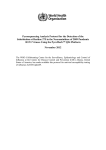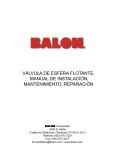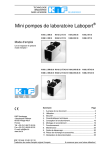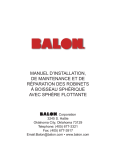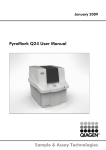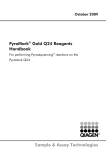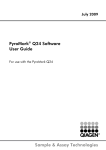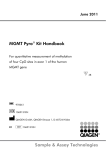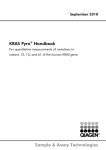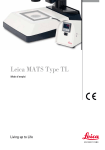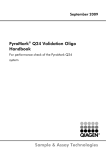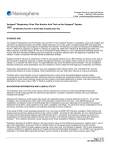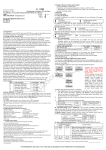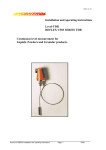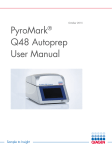Download Pyrosequencing Protocol for the Detection of the Substitution at
Transcript
Pyrosequencing Protocol for the Detection of the Substitution at Amino Acid Residue 275 in the Neuraminidase of 2009 Pandemic H1N1 Viruses Using the PyroMark™ Q96 ID Platform November 2012 The WHO Collaborating Centre for the Surveillance, Epidemiology and Control of Influenza at the Centers for Disease Control and Prevention (CDC) Atlanta, United States of America, has made available this protocol for antiviral susceptibility testing of influenza A(H1N1)pdm09. DEPARTMENT OF HEALTH & HUMAN SERVICES Public Health Service Centers for Disease Control and Prevention (CDC) Atlanta, GA 30333 Pyrosequencing Protocol for the Detection of the Substitution at Amino Acid Residue 275 in the Neuraminidase of 2009 Pandemic H1N1 Viruses Using the PyroMark™ Q96 ID Platform Prepared by: Molecular Epidemiology Team, Virus Surveillance and Diagnosis Branch, Influenza Division, National Center for Immunization and Respiratory Diseases, Centers for Disease Control and Prevention (L. Gubareva) Distribution Copy Effective: 04/19/2012 Page 1 of 43 DEPARTMENT OF HEALTH & HUMAN SERVICES Public Health Service Centers for Disease Control and Prevention (CDC) Atlanta, GA 30333 Table of Contents: I. Page Introduction 3 Pyrosequencing Assay Flow Chart 4 III. Safety Information 4 IV. Abbreviations 5 II. V. VI. VII. VIII. IX. Reverse Transcription Polymerase Reaction (RT-PCR) Protocol for the Generation of an Amplicon from Influenza Virus RNA This protocol describes the RT-PCR procedures used for the synthesis and amplification of influenza viral RNA isolated from clinical specimens or grown viral isolates. Pyrosequencing Sequence Analysis (SQA) Protocol Using the PyroMark™ Q96 ID Platform This protocol describes the pyrosequencing assay that is used for partial sequencing of the biotinylated amplicon generated in RT-PCR. 6 10 Pyrosequencing Single Nucleotide Polymorphism (SNP) Analysis Protocol Using the PyroMark™ Q96 ID Platform This protocol describes the pyrosequencing SNP assay that is used for partial sequencing of the biotinylated amplicon generated in RT-PCR. 24 Reference Material This document contains the reference viruses, RT-PCR and sequencing primers, amount of RT-PCR product needed for pyrosequencing, name of the target, dispensation order, pyrogram examples and a sequence library. 39 References 42 (L. Gubareva) Distribution Copy Effective: 04/19/2012 Page 2 of 43 DEPARTMENT OF HEALTH & HUMAN SERVICES Public Health Service Centers for Disease Control and Prevention (CDC) Atlanta, GA 30333 I. Introduction For the prophylaxis and treatment of influenza A virus infections there are currently two classes of drugs that are available, M2 blockers (adamantanes) and neuraminidase inhibitors (NAIs). The emergence of influenza viruses resistant to these antiviral drugs have yielded a need for the extensive surveillance of molecular markers associated with antiviral resistance. A variety of methods are available for the monitoring of molecular markers associated with drug resistance. Sanger sequencing, high-resolution melting curve and real-time reverse-transcriptase PCR have been employed for the analysis of these molecular markers within the influenza virus genome. Although these methods are used for the analysis of influenza virus genomic variation, they have limitations. For example, real-time reverse-transcriptase PCR is dependent on the detection of specific mutations and is unable to detect additional mutations. The Sanger sequencing method has the ability to identify mutations, but it is not suitable for quantitative single nucleotide polymorphism (SNP) analysis. Sanger sequencing is also laborious, time consuming and it can be difficult to interpret the sequence chromatograms from samples containing multiple virus variants (quasispecies). Pyrosequencing technology differs from other sequencing technologies; during DNA synthesis, it generates a sequence in real-time. Nucleotide sequences are determined by the sequential addition and subsequent incorporation of nucleotides, which trigger a cascade of enzymatic reactions resulting in the release and detection of light. The amount of light signal produced is proportional to the amount of pyrophosphate that is released upon nucleotide incorporation, making it a quantitative analysis. Accurate quantitative analysis, together with other characteristics, makes the pyrosequencing method a desirable for the detection of influenza molecular markers associated with resistance to antiviral drugs. Pyrosequencing technology on the Biotage/QIAGEN platform is better suited for the analysis of short sequences, sequencing up to 100 nucleotides accurately. The quantitative analysis of nucleotide incorporation allows for an accurate SNP analysis, enabling the detection of minor variants present at 10% or lower. In one pyrosequencing run, it is possible to analyze up to 96 samples (PyroMark Q96), which is valuable in the high-throughput screening for molecular markers associated with drug resistance. This method is also less laborious than the conventional Sanger sequencing and preparation of the pyrosequencing reactions with RT-PCR template along with the pyrosequencing run may be completed within 1.5-2 hours. The pyrosequencing reaction In the pyrosequencing reaction, biotinylated single-stranded DNA templates are bound to Streptavidin Sepharose™ beads in a solution containing enzymes and substrates. DNA polymerase assists in the incorporation of a dispensed deoxyribonucleotide triphosphate (dNTP) into the DNA resulting in the release of pyrophosphate (PPi). The PPi is then converted into ATP via ATP sulfurylase in the presence of adenosine 5'-phosphosulfate (APS). The ATP is used by luciferase to aid in the production of a light signal by converting luciferin to oxyluciferin. The height of each peak produced by this light signal, as can be seen in a pyrogram, is proportional to the amount of ATP processed. To avoid the recognition of deoxyadenosine triphosphate (dATP) by luciferase, an analog of ATP, deoxyadenosine alfa-thio triphosphate (dATPαS), is used by the DNA polymerase for incorporation. Apyrase is also present in the solution and is used to degrade any unincorporated nucleotides. (L. Gubareva) Distribution Copy Effective: 04/19/2012 Page 3 of 43 DEPARTMENT OF HEALTH & HUMAN SERVICES Public Health Service Centers for Disease Control and Prevention (CDC) Atlanta, GA 30333 II. Pyrosequencing Assay Flow Chart: (Influenza subtype determination and RNA isolation are not included in this protocol) III. Safety Information: These protocols can be performed under biosafety level 1 or 2 (BSL-1/BSL-2) conditions (should be in compliance with institutional regulatory requirements) by trained personnel with appropriate personal protective equipment (PPE) using the standard aseptic technique. (L. Gubareva) Distribution Copy Effective: 04/19/2012 Page 4 of 43 DEPARTMENT OF HEALTH & HUMAN SERVICES Public Health Service Centers for Disease Control and Prevention (CDC) Atlanta, GA 30333 IV. Abbreviations: A(H1N1)pdm09 – the 2009 A(H1N1) pandemic influenza virus A(H1N1) – the pre-pandemic A(H1N1) influenza virus AQ – allele quantification dNTP – deoxyribonucleotide triphosphate H – histidine NA – neuraminidase PPi – pyrophosphate RT-PCR – reverse transcription-polymerase chain reaction SNP – single nucleotide polymorphism SQA – sequence analysis Y – tyrosine NA amino acid numbering by NA subtype N1 H275 (L. Gubareva) N2 H274 Distribution Copy Effective: 04/19/2012 Page 5 of 43 DEPARTMENT OF HEALTH & HUMAN SERVICES Public Health Service Centers for Disease Control and Prevention (CDC) Atlanta, GA 30333 V. Reverse Transcription Polymerase Reaction (RT-PCR) Protocol for the Generation of an Amplicon from Influenza Virus RNA NOTES: This procedure is provided for Research Use Only. These protocols are not intended to be used for commercial development or for-profit testing. Please do not distribute these procedures to other laboratories or commercial entities. Names of vendors or manufacturers are provided as examples of suitable product sources only. Inclusion does not imply endorsement. 1 Purpose This protocol describes the RT-PCR procedures used for cDNA synthesis and amplification of influenza viral RNA isolated from clinical specimens or grown viral isolates. The RT-PCR primers are found in “ Reference Material” (section VIII). The RT-PCR amplicon generated is used in the pyrosequencing protocol(s) (section VI and/or VII). 2 Scope This procedure is for use by the community of Public Health Laboratories with basic experience in RNA isolation, RT-PCR, and pyrosequencing. 3 Equipment Thermal Cycler: DNA Engine® Tetrad 2 4 (Bio-Rad) Reagents and Supplies RT-PCR primer: Stocks of 20 µM, in aliquots of 20 µl, should be stored at -20°C. The sequences of primers can be found in section VIII part 2. The primers are provided for synthesis by the testing lab/group. Superscript™ III One-Step RT-PCR System with Platinum® Taq High Fidelity (Invitrogen) Protector RNase Inhibitor (Roche) 1.5 ml sterile Eppendorf tubes (Fisher) Flat-Top 96-well PCR reaction plates (ISC BioExpress) Strip Caps for Flat-Top PCR reaction plates (ISC BioExpress) 0.2 ml PCR tubes (ISC BioExpress) Assorted pipettes and pipette tips (Rainin) (L. Gubareva) Distribution Copy Effective: 04/19/2012 Page 6 of 43 DEPARTMENT OF HEALTH & HUMAN SERVICES Public Health Service Centers for Disease Control and Prevention (CDC) Atlanta, GA 30333 Cold block for 96-well plate (ISC BioExpress) ® 2% Agarose E-Gels 96 (Invitrogen) ® 5 E-Base electrophoresis system (Invitrogen) Benchtop PCR Marker (Promega) Nuclease-free RT-PCR grade water (Ambion) Distilled deionized water (Mediatech) Procedure 5.1 RNA Isolation RNA isolation procedures should be qualified and validated for recovery and purity before testing specimens. Commercially available isolation procedures - including QIAamp®Viral RNA Mini Kit (Qiagen), RNeasy® Mini Kit (Qiagen), MagNA Pure Compact RNA Isolation Kit (Roche), MagNA Pure LC RNA Isolation Kit II (Roche), and MagNA Pure Total Nucleic Acid Kit (Roche) - have been shown to generate highly purified RNA when following manufacturer’s recommended procedures. Performance of RT-PCR based assays depend on the amount and quality of the RNA sample. 5.2 Programming the Thermal Cycler The following program incorporates cDNA synthesis immediately followed by PCR amplification. Step 1: Incubate, 50°C for 30 minutes Step 2: Denature, 94°C for 2 minutes Step 3: Denature, 94°C for 15 seconds Step 4: Anneal, 55°C for 30 seconds Step 5: Extend, 68°C for 1 minute Step 6: Repeat steps 3-5 for 45 cycles Step 7: Extend, 68°C for 5 minutes Step 8: Hold, 4°C forever (L. Gubareva) Distribution Copy Effective: 04/19/2012 Page 7 of 43 DEPARTMENT OF HEALTH & HUMAN SERVICES Public Health Service Centers for Disease Control and Prevention (CDC) Atlanta, GA 30333 5.3 Preparation of the RT-PCR Reaction Mix and Thermal Cycling 5.3.1 Combine the components of the Superscript™ III One-Step RT-PCR System to prepare a reaction mix (Table 1). For multiple reactions, prepare a master mix with some excess of reagent to allow for controls and pipetting error. For example, for 96 samples, prepare a master mix for 100 samples. 5.3.1.1 If using a 50 μl reaction volume, aliquot 45 μl of the master mix into the wells of a 96-well PCR plate or into 0.2 ml PCR tubes, on a cold block. Add 5 μl of RNA from test and reference viruses in the corresponding well/tube. Close wells on the plate with stripped caps or foil and close tubes with caps. 5.3.1.2 If using a 25 µl reaction volume (Table 1), combine 22.5 µl of the master mix with 2.5 µl viral RNA. 5.3.2 Briefly centrifuge to ensure that all of the components are at the bottom of the amplification tube. 5.3.3 Place the plate/tubes in the thermal cycler and run the RT-PCR program (see 5.2). 5.3.4 Analysis of the RT-PCR product should be made by gel electrophoresis to determine the production of an amplicon of the appropriate length. (L. Gubareva) Distribution Copy Effective: 04/19/2012 Page 8 of 43 DEPARTMENT OF HEALTH & HUMAN SERVICES Public Health Service Centers for Disease Control and Prevention (CDC) Atlanta, GA 30333 Table 1. RT-PCR Reaction Components Component 1 Reaction 1 Reaction (50 µl volume) (25 µl volume) 2X Reaction Mix 25 µl 12.5 µl Forward Primer (20 µM) 1 µl 0.5 µl Reverse Primer (20 µM) 1 µl 0.5 µl SuperScriptTM III High Fidelity Enzyme Mix 1 µl 0.5 µl RNAse Inhibitor 0.5 µl 0.25 µl Nuclease-Free Water 16.5 µl 8.25 µl Template RNA 5 µl 2.5 µl Total 50 µl 25 µl Note: One of the RT-PCR primers used is biotinylated, refer to section VIII part 2. 6 Other SOP’s and Documents User’s Guide for Superscript™ III One-Step RT-PCR System with Platinum® Taq High Fidelity. (L. Gubareva) Distribution Copy Effective: 04/19/2012 Page 9 of 43 DEPARTMENT OF HEALTH & HUMAN SERVICES Public Health Service Centers for Disease Control and Prevention (CDC) Atlanta, GA 30333 VI. Pyrosequencing Sequence Analysis (SQA) Protocol Using the PyroMark™ Q96 ID Platform NOTES: This procedure is provided for Research Use Only. These protocols are not intended to be used for commercial development or for-profit testing. Please do not distribute these procedures to other laboratories or commercial entities. When the presence of the H275Y variant is detected, it is suggested that the SNP analysis be run, which allows for allele quantification (proportion of H275 and H275Y variants (C or T at nt823, respectively). Names of vendors or manufacturers are provided as examples of suitable product sources only. Inclusion does not imply endorsement. 1 Purpose This protocol describes the pyrosequencing assay that is used for partial sequencing of the biotinylated amplicon generated in RT-PCR. This protocol is to be used in conjunction with the “ Reverse Transcription Polymerase Chain Reaction (RT-PCR) Protocol for the Generation of an Amplicon from Influenza Virus RNA” (section V) and “ Reference Material” (section VIII). 2 Scope This procedure is for use by the community of Public Health Laboratories with basic experience in RNA isolation, RT-PCR, and pyrosequencing. 3 Equipment PyroMark™ Q96 ID Instrument PyroMark™ Vacuum Prep Workstation and Tool PSQ96 Sample Prep Thermoplate Vacuum Pump Orbital Plate Shaker Digital Heat Block 4 (Qiagen) (Qiagen) (Qiagen) (Laboport) (Labnet) (VWR) Reagents and Supplies Sequencing primer: Stocks of 100 µM, in aliquots of 20 µl, should be stored at -20°C. The sequence of the primer can be found in section VIII part 2. The primer sequence is provided for synthesis by the testing lab/group. Streptavidin Sepharose™ High Performance beads (GE Healthcare) PyroMark™ Binding Buffer (Qiagen) PyroMark™ Annealing Buffer (Qiagen) PyroMark™ Denaturation Solution (Qiagen) PyroMark™ 10X Wash Buffer (Tris Acetate) PyroMark™ Gold Reagents (Qiagen) (Qiagen) (L. Gubareva) Distribution Copy Effective: 04/19/2012 Page 10 of 43 DEPARTMENT OF HEALTH & HUMAN SERVICES Public Health Service Centers for Disease Control and Prevention (CDC) Atlanta, GA 30333 Note: Buffers, Sepharose Beads, and PyroGold Reagents should be stored at 4°C PSQ96 Plate Low 96-well clear plastic plates (Qiagen) 96% Ethanol (Fisher) 15 ml Falcon™ conical tubes (Fisher) Plastic Falcon™ pipettes and Pipette-Aid™ (Fisher) Assorted pipettes and pipette tips (Rainin) 96-well plastic PCR reaction plates (Fisher) Distilled deionized water (Mediatech) Nuclease-free water (Ambion) Plastic troughs/trays for sample clean up (Qiagen) Filter probes for Vacuum prep tool (Qiagen) Plastic bottles for preparing buffers and reagents (Nalgene) 5 6 Reference Viruses and Biotinylated Amplicon (Template) 5.1 These reference viruses are to be used directly for viral RNA isolation and pyrosequencing. This is because virus passage in cell culture can alter the genetic make-up of the virus, which may affect the pyrosequencing results. For example, an H275Y variant could revert to a wild-type sequence (H275). Examples of reference viruses may be found in part 1 of section VIII. 5.2 A biotinylated amplicon is generated using isolated viral RNA in an RT-PCR reaction as described in section V. Procedure 6.1 Preparation of Run Sample Sheet and Import into PyroMark™ ID Platform 6.1.1 Prepare an MS Excel spreadsheet of samples to be tested (Figure 1) and save as a text, tab delimited file (*.txt). 6.1.2 Import the saved text file into the PyroMark™ ID platform as follows: 1. 2. 3. 4. 5. 6. 7. 8. 9. (L. Gubareva) Open the Pyrosequencing Data Exchange Tool Click on “File”, Click on “Login” Select “login to import database” Enter Username Enter Password Click “OK” Click “Import” Browse to find run sample sheet (saved in Step 6.1.1) Click “Import”. Prompt appears saying “Import done”. Click “OK” and close the Pyrosequencing Data Exchange Tool. Note: This is the default setup for the platform and may be different if the user has altered the original setup profile. Distribution Copy Effective: 04/19/2012 Page 11 of 43 DEPARTMENT OF HEALTH & HUMAN SERVICES Public Health Service Centers for Disease Control and Prevention (CDC) Atlanta, GA 30333 6.2 Setup of Pyrosequencing Reaction 6.2.1 Set the digital heat block to 89°C, place the PSQ96 Sample Prep Thermoplate holder upon the heat block and allow the plate to heat to 89°C. 6.2.2 Remove the Streptavidin Sepharose™ beads, PyroMark™ Binding Buffer, Annealing Buffer, Denaturation Solution, 1X Wash Buffer and 70% Ethanol from 4°C storage and place at room temperature (Note: Dilute PyroMark™ 10X Wash Buffer in distilled deionized water 1/10 to make the 1X working solution of wash buffer listed above. Dilute 96% ethanol to 70% ethanol by combining 700 ml of 96% ethanol and 280 ml of distilled deionized water). 6.2.3 When at room temperature, prepare binding buffer solution (60 µl of binding buffer solution is needed per sample). For 96 samples, combine 4 ml Binding Buffer, 2 ml distilled deionized water and 300 µl Streptavidin Sepharose™ beads (resuspend beads by inverting) in a 15 ml conical tube. Briefly mix the binding buffer solution by inverting. 6.2.4 Aliquot 60 µl of the binding buffer solution into the wells of a 96-well PCR plate that will be used for pyrosequencing the RT-PCR product. 6.2.5 Transfer 20 μl of RT-PCR product into the respective wells of the 96-well plate containing binding buffer solution. Cover the plate with a plastic adhesive cover, place on an orbital plate shaker and agitate at 1400 rpm for at least 10 minutes. Allow the plate to continue shaking until ready to begin the sample clean-up steps with the PyroMark™ Vacuum Prep Workstation (Step 6.2.11). 6.2.6 Prepare annealing buffer solution (40 µl of annealing buffer solution is needed per sample). For 96 samples, combine 4.4 ml Annealing Buffer and 20 µl of the required 100 µM sequencing primer (final concentration 0.45 µM) in a 15 ml conical tube. Briefly vortex to mix the annealing buffer solution. 6.2.7 Aliquot 40 µl of the annealing buffer solution into the respective wells of a 96-well clear plastic plate (PSQ96 Plate Low). Place the plate onto its respective position on the Vacuum Prep Workstation (Figure 2). Set plastic reagent trays in their designated positions on the Vacuum Prep Workstation (Figure 2) and fill with 70% Ethanol, Denaturation Solution, 1X Wash Buffer and distilled deionized water, respectively. 6.2.8 6.2.9 When Step 6.2.5 is close to completion (3-5 minutes left), prime the filters in the PyroMark™ Prep Tool by adding distilled deionized water into a plastic reagent tray and place beneath the tool (Figure 2). Turn ON the vacuum switch for both the Vacuum Prep Workstation and the vacuum pump. This will allow water to flush through and prime the filter probes on the Prep Tool. Let the tool sit in the plastic reagent tray until it is ready to use. 6.2.10 When Step 6.2.5 is complete, remove the plastic PCR plate containing the PCR product bound to Streptavidin Sepharose™ beads from the shaker. Place (L. Gubareva) Distribution Copy Effective: 04/19/2012 Page 12 of 43 DEPARTMENT OF HEALTH & HUMAN SERVICES Public Health Service Centers for Disease Control and Prevention (CDC) Atlanta, GA 30333 the plate onto its respective position on the Vacuum Prep Workstation. Gently remove plastic adhesive cover from plate to avoid splashing. 6.2.11 With the vacuum ON, as described in Step 6.2.9, place the Prep Tool into the respective wells of the 96-well PCR plate until the entire volume has been collected (5-10 seconds). The Streptavidin Sepharose™ beads with immobilized amplicons will be captured on the tips of the respective filter probes of the Prep Tool and will be visible. Note: The tips of the probes are white like the beads. The captured beads will appear as a concave white substance on the tips of the probes. 6.2.12 With the vacuum still ON, transfer the Prep Tool into the reagent tray containing 70% ethanol and flush until the tray is almost emptied (15-25 seconds), then lift to drain the tool. This step allows any unbound amplicon or unincorporated reagents from the RT-PCR reaction to be washed off. 6.2.13 With the vacuum still ON, transfer the Prep Tool into the reagent tray containing Denaturation Solution and flush until the tray is almost emptied (15-25 seconds), then lift to drain the tool. This step allows for the denaturation of the double-stranded DNA amplicon containing a biotintagged, single-stranded, DNA template. The complementary strand synthesized from the non-biotinylated primer will be washed away. 6.2.14 With the vacuum still ON, transfer the Prep Tool into the reagent tray with 1X Wash Buffer and flush until the tray is almost emptied (15-25 seconds), then lift to drain the tool for 30-40 seconds. 6.2.15 Turn the vacuum OFF and disconnect the Prep Tool from the vacuum line. Place the Prep Tool into the 96-well PSQ96 Plate Low containing annealing buffer solution (including sequencing primer). Move the Prep Tool in circular motions (15-25 seconds) in the PSQ96 Plate Low to release beads bound to the single-stranded template. Note: The mixture on the plate should now appear ‘cloudy’ and the white concave substance should no longer be present on the tips of the probes. 6.2.16 Denaturation of template/primer mixture: Place the PSQ96 Plate Low onto the PSQ96 Sample Prep Thermoplate holder on the 89°C heat block for 4 minutes. Do not leave the PSQ96 Plate Low on the heat block for more than 4 minutes. 6.2.17 Annealing template and primer: Remove the PSQ96 Sample Prep Thermoplate holder with the PSQ Plate Low from the 89°C heat block and allow it to cool on a bench for 10 minutes. 6.2.18 Remove the PSQ Plate Low from the PSQ96 Sample Prep Thermoplate holder and allow it to rest directly on the bench for an additional 4 minutes to end the annealing step. Note: During the 10 minutes, when the plate on the holder is cooling (Step 6.2.17), Steps 6.3.1 through 6.3.11 can be completed. (L. Gubareva) Distribution Copy Effective: 04/19/2012 Page 13 of 43 DEPARTMENT OF HEALTH & HUMAN SERVICES Public Health Service Centers for Disease Control and Prevention (CDC) Atlanta, GA 30333 6.3 Pyrosequencing Using the PyroMark™ Q96 ID Equipment and Software 6.3.1 Open PyroMark™ Q96 ID software. 6.3.2 Enter Login name; Enter password; click “OK”. 6.3.3 Select “SQA” on the left side of the program window (Figure 3). 6.3.4 To start a new run, click on the “SQA Runs” icon (Figure 4) and expand the “Import” folder to see the imported run, double-click to open the file. 6.3.5 Under the “General” tab, in the drop down “Instrument Parameters” menu, select “Instrument Parameters Code 000X”. The number for “X” should match what is on the reagent cartridge to be used. Instructions for the setup of a new Instrument Parameter are provided with the reagent cartridge. 6.3.6 Select a dispensation entry: 6.3.6.1 Go to the “Setup” tab, and under “Entry” click to select the dispensation order (Figure 4). 6.3.6.2 If the target specific entry is not in the Entry list, then create a new SQA entry. To create a new SQA entry, click on the “SQA Entries” icon and right click on the “SQA” folder and select “New Entry”. Under “Entry ID:” type in the name found in part 4 of section VIII. Under the “Dispensation order” tab, enter the sequence found in part 5 of section VIII in the “Entered dispensation order:” box. The sequence should be visible under the “Expanded dispensation order:” box (Figure 3). 6.3.7 Click on the Pencil tool and highlight all the wells that are to be used. The name of the entry should now appear in these wells. 6.3.8 Click the “View” tab to reveal a drop-down menu. Select “Run” to see the volumes of the enzyme (E), substrate (S) and nucleotides (A, C, G and T) that need to be added to the cartridge. Remove the PyroMark™ Gold reagent kit from 4°C storage. 6.3.9 6.3.10 Reconstitute both the enzyme (E) and the substrate (S) in 620 µl nuclease-free water. Swirl to mix, DO NOT vortex. The reconstituted enzyme (E) and the substrate (S) are stable for at least 5 days at 4°C, or for one freeze (20°C)/thaw cycle. 6.3.11 Ensure that the dispensation pins (needles) on the cartridge are clean and not bent before use. To do so, fill each channel in the cartridge with distilled deionized water, seal the channel and apply pressure. Water should stream straight down out of the pin. Remove the excess water and add the corresponding amount of enzyme, substrate and nucleotides (see 6.3.8) into each channel of the cartridge with the label facing the user, as shown in Figure 5. Load the volumes carefully to ensure that air bubbles are not created. (L. Gubareva) Distribution Copy Effective: 04/19/2012 Page 14 of 43 DEPARTMENT OF HEALTH & HUMAN SERVICES Public Health Service Centers for Disease Control and Prevention (CDC) Atlanta, GA 30333 Note: If the water does not stream through the pins of the cartridge, the pins may be clogged. Soaking the pins in warm water may help unclog the pins. A cartridge with clogged pins should not be used and a new cartridge may be needed. 6.3.12 Load the PSQ96 Plate Low containing the annealed DNA template and sequencing primer onto the PyroMark™ Q96 ID instrument. 6.3.13 Load the cartridge containing enzyme, substrate and nucleotides onto the PyroMark™ Q96 ID instrument, with the cartridge label facing towards the user. 6.3.14 From the drop-down menu in the “Instrument” option, select “PyroMark™ ID”. Note: The specific name of the instrument may vary depending on the setup of the machine. Ensure that the PSQ96 Plate Low and cartridge have been loaded into the instrument selected in the drop-down menu. 6.3.15 Click “Run” to start the pyrosequencing reaction. Ensure that the substrate peak appears after the substrate is added to confirm that the enzyme and substrate reagents are working. 6.4 6.5 Cleaning the Instrument 6.4.1 To clean the Prep Tool, place the hand tool in the reagent tray containing distilled deionized water, reconnect the vacuum line to the hand tool and turn ON the vacuum. Flush until the tray is almost emptied (1-2 minutes). 6.4.2 Turn the vacuum OFF. Remove the reagent trays from the Vacuum Prep Workstation, discard excess solutions and rinse the reagent trays with distilled deionized water. Set the reagent trays upon paper towels on the bench to dry. 6.4.3 When the Pyrosequencing run is finished, remove and discard the PSQ96 Plate Low from the PyroMark™ Q96 ID instrument. 6.4.4 Remove the cartridge from the PyroMark™ Q96 ID instrument and discard unused enzyme, substrate and nucleotides. Wash the cartridge at least 3 times with distilled deionized water and check to make sure that all dispensation pins are clean by applying pressure to the top of each of the channels in the cartridge (see Note for 6.3.11). Analysis of Pyrosequencing Data Using IdentiFire™ Software 6.5.1 When the SQA run is complete, click “Close”. 6.5.2 Reopen the run from the import folder to reveal the SQA analysis window (Figure 6). 6.5.3 Under the “Analyze” option, select “All” to analyze all the samples in the run. To analyze only selected wells, first highlight the wells you wish to analyze, then click “Selected”. 6.5.4 When analysis is complete, click “Save”. (L. Gubareva) Distribution Copy Effective: 04/19/2012 Page 15 of 43 DEPARTMENT OF HEALTH & HUMAN SERVICES Public Health Service Centers for Disease Control and Prevention (CDC) Atlanta, GA 30333 Note: The icon for a completed run file is a blue check, and will replace the green icon, which denotes a run setup that has not yet been run. Note: It is CRITICAL that each pyrogram be examined and verified visually, even when using IdentiFire™. 6.6 6.5.5 Close the PyroMark™ ID software. 6.5.6 Prior to IdentiFire™ analysis, copy the IdentiFire™ Library (found in part 7 of section VIII) containing the pyrosequencing target region of interest (wildtype and variant genotypes) and paste into a new MS Word file, save as a text (*.txt). 6.5.7 Open IdentiFire™ software. Under the “Sequence Input” select the “SQA Runs” tab. Expand the SQA Runs folder to select the run to be analyzed. To analyze all samples in the run, click “Add all”. To analyze only selected samples, highlight samples of interest and click “Add”. 6.5.8 Under “Analysis Setup”, select the corresponding library (created in Step 6.5.6) in the “Sequence Library” drop-down, or select “Browse…” to locate where the library is saved. Click on “Add to All”. Select the play/start button to begin analysis. 6.5.9 After analysis, generate reports and save. When saving reports, select the option "All Reports". Analysis of Pyrosequencing Data Below are examples showing the common target sequences. 1) Detection of A(H1N1)pdm09-wildtype (H275): AT CAC TAT (CAC)=wildtype H275 (L. Gubareva) Distribution Copy Effective: 04/19/2012 Page 16 of 43 DEPARTMENT OF HEALTH & HUMAN SERVICES Public Health Service Centers for Disease Control and Prevention (CDC) Atlanta, GA 30333 2) Detection of A(H1N1)pdm09-variant (H275Y): AT TAC TAT T(TAC)=variant H275Y 3) Detection of A(H1N1)pdm09-mixture-(H275H/Y): AT (C/T)AC TAT T(C/TAC)=mixture H275H/Y Note: Arrow shows the presence of C incorporation for T(CAC) virus variant. 4-5 are examples of pre-pandemic A(H1N1) pyrograms: 4) Detection of pre-pandemic A(H1N1)-wildtype (H275): TT CAT TAT GA (CAT)T=wildtype (L. Gubareva) Distribution Copy Effective: 04/19/2012 Page 17 of 43 DEPARTMENT OF HEALTH & HUMAN SERVICES Public Health Service Centers for Disease Control and Prevention (CDC) Atlanta, GA 30333 5) Detection of pre-pandemic A(H1N1)-variant (H275Y): TT TAT TAT GA TT(TAT)T=variant H275Y 7 8 Notes 7.1 This pyrosequencing protocol is for the detection of substitutions found in influenza and is not to be used for typing/subtyping; rather, it is to be used for viruses that have already been subtyped by another method (e.g., real-time RT-PCR). 7.2 A positive control is optional for the pyrosequencing assay, since the PyroMark™ Q96 ID provides a built-in quality control for each assay. Specifically, if a pyrogram is generated for any of your samples, this may serve as your positive control. 7.3 The naming of the sequences in the IdentiFire™ library can be changed to the users’ preference. 7.4 When the IdentiFire™ library is used, any mutations within the target region that were not in the sequences of the reference library will be identified by the software as mismatched sequences and the closest matches will be shown. 7.5 Because the PyroMark™ Q96 ID platform has limitations, it is suggested that each pyrogram be examined and verified visually. One such limitation is that if the target sequence contains repeats of more than four or five identical nucleotides, the pyrogram peak heights may no longer be directly proportional to the number of nucleotides. In such cases, the software may overcall or miscall the nucleotide in the final sequence results. 7.6 Both the PyroMark™ Q96 ID and the IdentiFire™ software will not be able to detect mixtures (e.g., H/Y at 275). Mixtures must be verified visually. 7.7 As the virus evolves, the IdentiFire™ library sequences and primers may need to be updated. Other SOPs and Documents PyroMark™ Q96 ID User’s Manual. (L. Gubareva) Distribution Copy Effective: 04/19/2012 Page 18 of 43 DEPARTMENT OF HEALTH & HUMAN SERVICES Public Health Service Centers for Disease Control and Prevention (CDC) Atlanta, GA 30333 Index of Figures Figure 1. Example of a Run Sample Sheet for PyroMark™ Q96 ID Platform. Figure 2. The PyroMark™ Q96 ID Vacuum Prep Workstation. Figure 3. Example of Defining SQA Entry. Figure 4. Example of PyroMark™ Q96 ID Software Showing SQA Run Setup. Figure 5. PyroMark™ Q96 ID Cartridge Setup. Figure 6. Example of an SQA Run Analysis. (L. Gubareva) Distribution Copy Effective: 04/19/2012 Page 19 of 43 DEPARTMENT OF HEALTH & HUMAN SERVICES Public Health Service Centers for Disease Control and Prevention (CDC) Atlanta, GA 30333 Figure 1. Example of a Run Sample Sheet for PyroMark™ Q96 ID Platform. (L. Gubareva) Distribution Copy Effective: 04/19/2012 Page 20 of 43 DEPARTMENT OF HEALTH & HUMAN SERVICES Public Health Service Centers for Disease Control and Prevention (CDC) Atlanta, GA 30333 Figure 2. The PyroMark™ Q96 ID Vacuum Prep Workstation. (L. Gubareva) Distribution Copy Effective: 04/19/2012 Page 21 of 43 DEPARTMENT OF HEALTH & HUMAN SERVICES Public Health Service Centers for Disease Control and Prevention (CDC) Atlanta, GA 30333 Figure 3. Example of Defining SQA Entry. (L. Gubareva) Distribution Copy Effective: 04/19/2012 Page 22 of 43 DEPARTMENT OF HEALTH & HUMAN SERVICES Public Health Service Centers for Disease Control and Prevention (CDC) Atlanta, GA 30333 Figure 4. Example of PyroMark™ Q96 ID Software Showing SQA Run Setup. G C S T A E Label Should Face User Figure 5. PyroMark™ Q96 ID Cartridge Setup. (L. Gubareva) Distribution Copy Effective: 04/19/2012 Page 23 of 43 DEPARTMENT OF HEALTH & HUMAN SERVICES Public Health Service Centers for Disease Control and Prevention (CDC) Atlanta, GA 30333 Figure 6. Example of an SQA Run Analysis. (L. Gubareva) Distribution Copy Effective: 04/19/2012 Page 24 of 43 DEPARTMENT OF HEALTH & HUMAN SERVICES Public Health Service Centers for Disease Control and Prevention (CDC) Atlanta, GA 30333 VII. Pyrosequencing Single Nucleotide Polymorphism (SNP) Analysis Protocol Using the PyroMark™ Q96 ID Platform NOTES: This procedure is provided for Research Use Only. These protocols are not intended to be used for commercial development or for-profit testing. Please do not distribute these procedures to other laboratories or commercial entities. Analysis of samples using the SNP assay requires knowledge of the sequence. To assure that there is no natural variation within the targeted sequence, it is recommended that the SQA assay be run first. Moreover, compared to SQA, SNP analysis is more susceptible to interference by various factors (e.g., quality of RT-PCR product, background, cartridge issues, etc.). Names of vendors or manufacturers are provided as examples of suitable product sources only. Inclusion does not imply endorsement. 1 Purpose This protocol is to be used in conjunction with the “Reverse Transcription Polymerase Chain Reaction (RT-PCR) Protocol for the Generation of an Amplicon from Influenza Virus RNA” (section V), “Pyrosequencing SQA Protocol Using the PyroMark™ Q96 ID Platform” (section VI) and “Reference Material” (section VIII). This protocol describes the pyrosequencing assay that is used for partial sequencing of the biotinylated amplicon generated in RT-PCR to detect and quantify the ratio of wild type and mutant variants in a viral population. The single nucleotide polymorphism (SNP) and allele quantification (AQ) analyses are performed on nucleotide 823 (the first nucleotide of codon 275- CAC) in the NA gene of the pandemic H1N1 virus. Cytosine (C) at the first position is present in the wild type viruses carrying histidine at position 275 in the NA protein, whereas thymine (T) at this position is present in mutant H1N1 virus variants carrying tyrosine at position 275 in the NA protein. 2 Scope This procedure is for use by the community of Public Health Laboratories with basic experience in RNA isolation, RT-PCR, and pyrosequencing. 3 Equipment PyroMark™ Q96 ID Instrument (Qiagen) PyroMark™ Vacuum Prep Workstation and Tool (Qiagen) PSQ96 Sample Prep Thermoplate (Qiagen) Vacuum Pump (Laboport) Orbital Plate Shaker (Labnet) Digital Heat Block (VWR) (L. Gubareva) Distribution Copy Effective: 04/19/2012 Page 25 of 43 DEPARTMENT OF HEALTH & HUMAN SERVICES Public Health Service Centers for Disease Control and Prevention (CDC) Atlanta, GA 30333 4 Reagents and Supplies Sequencing primer: Stocks of 100 µM, in aliquots of 20 µl, should be stored at -20°C. The sequences of primers can be found in section VIII part 2. The primer sequence is provided for synthesis by the testing lab/group. Streptavidin Sepharose™ High Performance beads (GE Healthcare) PyroMark™ Binding Buffer (Qiagen) PyroMark™ Annealing Buffer (Qiagen) PyroMark™ Denaturation Solution (Qiagen) PyroMark™ 10X Wash Buffer (Tris Acetate) (Qiagen) Pyro Gold Reagents (Qiagen) Note: Buffers, Sepharose Beads, and PyroGold Reagents should be stored at 4°C 5 PSQ96 Plate Low 96-well clear plastic plates (Qiagen) 96% Ethanol (Fisher) 15 ml Falcon™ conical tubes (Fisher) Plastic Falcon™ pipettes and Pipette-Aid™ (Fisher) Assorted pipettes and pipette tips (Rainin) 96-well plastic PCR reaction plates (Fisher) Distilled deionized water (Mediatech) Nuclease-free water (Ambion) Plastic troughs/trays for sample clean up (Qiagen) Filter probes for Vacuum prep tool (Qiagen) Plastic bottles for preparing buffers and reagents (Nalgene) Reference Viruses and Biotinylated Amplicon (Template) 5.1 5.2 These reference viruses are to be used directly for viral RNA isolation and pyrosequencing. This is because virus passage in cell culture can alter the genetic make-up of the virus, which may affect the pyrosequencing results. For example, an H275Y variant could revert to a wild-type sequence (H275). Examples of reference viruses for a particular target may be found in part 1 of section VIII. A biotinylated amplicon is generated using isolated viral RNA in an RT-PCR reaction as described in section V. (L. Gubareva) Distribution Copy Effective: 04/19/2012 Page 26 of 43 DEPARTMENT OF HEALTH & HUMAN SERVICES Public Health Service Centers for Disease Control and Prevention (CDC) Atlanta, GA 30333 6 Procedure 6.1 Preparation of Run Sample Sheet and Import into PyroMark™ ID Platform 6.1.1 Prepare an MS Excel spreadsheet of samples to be tested (Figure 1.) and save as a text, tab delimited file. Create a folder with the current date (the date the run is to be performed) and name the run sample sheet as the current date. If necessary, include additional information on the file name. Note: The “Run Type” should read “SNP”. 6.1.2 Import the saved text file into the PyroMark™ ID platform as follows: 10. Open the Pyrosequencing Data Exchange Tool 11. Click on “File”, Click on “Login” 12. Select “login to import database” 13. Enter Username 14. Enter Password 15. Click “OK” 16. Click “Import” 17. Browse to find run sample sheet (saved in step 6.1.1) 18. Click “Import”. Prompt appears saying “Import done”. Click “OK” and close the Pyrosequencing Data Exchange Tool. Note: This is the default setup for the platform and may be different if the user has altered the original setup profile. 6.2 Setup of Pyrosequencing Reaction See part 6.2 in “Pyrosequencing SQA Protocol Using the PyroMark™ Q96 ID Platform” (section VI). 6.3 Pyrosequencing Using the PyroMark™ Q96 ID Equipment and Software 6.3.1 Open PyroMark™ Q96 ID software. 6.3.2 Enter Login name; Enter password; click “OK”. 6.3.3 Select “SNP” on the left side of the program window (Figure 8). To start a new run, click on the “SNP Runs” icon (Figure 8) and expand the “Import” folder to see the imported run, double-click to open the file (imported in step 6.1.2). 6.3.4 (L. Gubareva) Under the “General” tab, in the drop down “Instrument Parameters” menu, select “Instrument Parameters Code 000X”. The specific number for “X” should match what is on the reagent cartridge to be used. Instructions for the setup of a new instrument parameter are provided with the reagent cartridge. Distribution Copy Effective: 04/19/2012 Page 27 of 43 DEPARTMENT OF HEALTH & HUMAN SERVICES Public Health Service Centers for Disease Control and Prevention (CDC) Atlanta, GA 30333 6.3.5 Select a dispensation entry: 6.3.5.1 Go to the “Setup” tab, and under “Entry” click to select the dispensation order (Figure 3). 6.3.5.2 If the target specific entry is not in the Entry list, then create a new SNP entry. To create a new SNP entry, click on the “Simplex Entries” icon and right click on the “Simplex Entries” folder and select “New Entry”. Under “Entry ID” type in the name “A(H1N1)pdm09-NA275”. Enter the sequence to be analyzed“ATC/TACTAT”- and click the “Dispensation Order” tab. The sequence should be visible under the “Dispensation order:” box (Figure 4). Note: Because of the natural genetic variability of the influenza virus genome, SNP analysis can be affected if mutations occur in the region near the site of analysis. Such mutations are rare, but will cause the sample to fail; for example, a virus variant with the silent mutation at nucleotide position 822 (T→C) of the NA gene. If a sample with this mutation is determined by SQA, the SNP analysis should be done with the following variant sequence: ACC/TACTAT (Figure 5B). The result will be inconclusive if such a variant is tested in SNP with the dispensation order generated for the major circulating virus variant (ATC/TACTAT) (Figure 5A). 6.3.6 Click on the Pencil tool and highlight all the wells that are to be used. The name of the entry should now appear in these wells. 6.3.7 Click the “View” tab to reveal a drop-down menu. Select “Run” to see the volumes of the enzyme (E), substrate (S) and nucleotides (A, C, G and T) that need to be added to the cartridge. 6.3.8 Remove the PyroGold reagent kit from 4oC storage. 6.3.9 Reconstitute both the enzyme (E) and the substrate (S) in 620 µl nuclease-free water. Swirl to mix, DO NOT vortex. The reconstituted enzyme (E) and the substrate (S) are stable for at least 5 days at 4°C, or for one freeze (-20°C)/thaw cycle. 6.3.10 Ensure that the dispensation pins (needles) on the cartridge are clean and not bent before use. To do so, fill each channel in the cartridge with distilled deionized water, seal the channel and apply pressure. Water should stream straight down out of the pin. Remove the excess water and add the corresponding amount of enzyme, substrate and nucleotides (see 6.3.8) into each channel of the cartridge with the label facing the user, as shown in Figure 6. Load the volumes carefully to ensure that air bubbles are not created. Note: If the water does not stream through the pins of the cartridge, the pins may be clogged. Soaking the pins in warm water may help unclog the pins. A cartridge with clogged pins should not be used and a new cartridge may be needed. (L. Gubareva) Distribution Copy Effective: 04/19/2012 Page 28 of 43 DEPARTMENT OF HEALTH & HUMAN SERVICES Public Health Service Centers for Disease Control and Prevention (CDC) Atlanta, GA 30333 6.3.11 Load the PSQ96 Plate Low containing the annealed DNA template and sequencing primer onto the PyroMark™ Q96 ID instrument. Load the cartridge containing enzyme, substrate and nucleotides onto the PyroMark™ Q96 ID instrument, with the cartridge label facing towards the user. 6.3.12 From the drop-down menu in the “Instrument” option, select “PyroMark™ ID”. Note: The specific name of the instrument may vary depending on the setup of the machine. Ensure that the PSQ96 Plate Low and cartridge have been loaded into the instrument selected in the drop-down menu. 6.3.13 Click “Run” to start the pyrosequencing reaction. Ensure that the substrate peak appears after the substrate is added to confirm that the enzyme and substrate reagents are working. 6.4 Cleaning the Instrument See part 6.4 of “Pyrosequencing SQA Protocol Using the PyroMark™ Q96 ID Platform” (section VI). 6.5 Analysis of Pyrosequencing Data using SNP or Allele Quantification (AQ) Mode 6.5.1 When the SNP run is complete, click “Close”. 6.5.2 Reopen the run from the import folder to reveal the SNP analysis window (Figure 7). 6.5.3 Pyrosequencing data may be analyzed in two modes: SNP or AQ. SNP mode will provide the nucleotide present at the site of analysis (for example: T/T, T/C or C/C; Figure 8). AQ mode will provide the percentage of each nucleotide present (Figure 9). 6.5.4 Under the “Well overview” tab, select the SNP or AQ mode and click “All” to analyze all the samples in the run. To analyze only wells of interest, first highlight the wells you wish to analyze, and then click “Selected”. 6.5.5 When analysis is complete, click “Save”. 6.5.6 Click on the “Report” tab in either mode, select “Custom delimited short” and save the run as “.txt” file. 6.5.7 In Microsoft Excel, go to “import external date”, browse to locate the run file and open it, choose “Delimited”, click on “Next” and select “Semi-colon and other”. Click on “Finish”. This generates an excel sheet with summarized results of the SNP or AQ. The table can be edited as needed. 6.5.8 Pyrograms may also be generated. While in either mode, select the “Report” tab. Here you may choose all or select specific wells as well as edit the “number of rows” to allow for multiple pyrograms to be shown per page. (L. Gubareva) Distribution Copy Effective: 04/19/2012 Page 29 of 43 DEPARTMENT OF HEALTH & HUMAN SERVICES Public Health Service Centers for Disease Control and Prevention (CDC) Atlanta, GA 30333 Note: If only specific pyrograms are needed, you must select these wells before selecting the “Report” tab and then click save. This will generate a word document with the pyrograms of the run and the results of the analysis. 6.6 Analysis of Pyrosequencing Data Below are examples showing the common target sequences. 1) Detection of A(H1N1)pdm09-wildtype (H275): AT CAC TAT (CAC)=wildtype H275 2) Detection of A(H1N1)pdm09-variant (H275Y): AT TAC TAT T(TAC)=variant H275Y (L. Gubareva) Distribution Copy Effective: 04/19/2012 Page 30 of 43 DEPARTMENT OF HEALTH & HUMAN SERVICES Public Health Service Centers for Disease Control and Prevention (CDC) Atlanta, GA 30333 3) Detection of A(H1N1)pdm09-mixture-(H275H/Y): AT (C/T)AC TAT T(C/TAC)=mixture H275H/Y 7 Notes See notes in part 7 of “Pyrosequencing SQA Protocol Using the PyroMark™ Q96 ID Platform” (section VI). 8 Other SOPs and Documents PyroMark™ Q96 ID User’s Manual. Index of Figures Figure 1. Example of a Run Sample Sheet for PyroMark™ Q96 ID Platform. Figure 2. Example of a SNP Run for PyroMark™ Q96 ID Platform. Figure 3. Example of PyroMark™ Q96 ID Software Showing SNP Run Setup. Figure 4. Example of Defining SNP Entry. Figure 5. SNP Results for NA H275 with a Silent Mutation at Nucleic Acid Position 822 (T→C). Figure 6. PyroMark™ Q96 ID Cartridge Setup. Figure 7. Example of a Completed SNP Run. Figure 8. Example of Run Analysis in SNP Mode. Figure 9. Example of Run Analysis in AQ Mode. (L. Gubareva) Distribution Copy Effective: 04/19/2012 Page 31 of 43 DEPARTMENT OF HEALTH & HUMAN SERVICES Public Health Service Centers for Disease Control and Prevention (CDC) Atlanta, GA 30333 Figure 1. Example of a Run Sample Sheet for PyroMark™ Q96 ID Platform. (L. Gubareva) Distribution Copy Effective: 04/19/2012 Page 32 of 43 DEPARTMENT OF HEALTH & HUMAN SERVICES Public Health Service Centers for Disease Control and Prevention (CDC) Atlanta, GA 30333 Figure 2. Example of a SNP Run for PyroMark™ Q96 ID Platform. (L. Gubareva) Distribution Copy Effective: 04/19/2012 Page 33 of 43 DEPARTMENT OF HEALTH & HUMAN SERVICES Public Health Service Centers for Disease Control and Prevention (CDC) Atlanta, GA 30333 Figure 3. Example of PyroMark™ Q96 ID Software Showing SNP Run Setup. (L. Gubareva) Distribution Copy Effective: 04/19/2012 Page 34 of 43 DEPARTMENT OF HEALTH & HUMAN SERVICES Public Health Service Centers for Disease Control and Prevention (CDC) Atlanta, GA 30333 Figure 4. Example of Defining SNP Entry. (L. Gubareva) Distribution Copy Effective: 04/19/2012 Page 35 of 43 DEPARTMENT OF HEALTH & HUMAN SERVICES Public Health Service Centers for Disease Control and Prevention (CDC) Atlanta, GA 30333 A. B. Figure 5. SNP Results for NA H275 with a Silent Mutation at Nucleic Acid Position 822 (T→C). (A) Analysis using the dispensation generated for the major circulating virus variant (ATT/CATTA). (B) Analysis using the dispensation generated for the silent virus variant (ACT/CATTA). G C S T A E Label Should Face User Figure 6. PyroMark™ Q96 ID Cartridge Setup. (L. Gubareva) Distribution Copy Effective: 04/19/2012 Page 36 of 43 DEPARTMENT OF HEALTH & HUMAN SERVICES Public Health Service Centers for Disease Control and Prevention (CDC) Atlanta, GA 30333 Figure 7. Example of a Completed SNP Run. (L. Gubareva) Distribution Copy Effective: 04/19/2012 Page 37 of 43 DEPARTMENT OF HEALTH & HUMAN SERVICES Public Health Service Centers for Disease Control and Prevention (CDC) Atlanta, GA 30333 Figure 8. Example of Run Analysis in SNP Mode. (L. Gubareva) Distribution Copy Effective: 04/19/2012 Page 38 of 43 DEPARTMENT OF HEALTH & HUMAN SERVICES Public Health Service Centers for Disease Control and Prevention (CDC) Atlanta, GA 30333 Figure 9. Example of Run Analysis in AQ Mode. (L. Gubareva) Distribution Copy Effective: 04/19/2012 Page 39 of 43 DEPARTMENT OF HEALTH & HUMAN SERVICES Public Health Service Centers for Disease Control and Prevention (CDC) Atlanta, GA 30333 VIII. Reference Material NOTES: This document may not be used as a standalone document. This document is provided for Research Use Only. These protocols are not intended to be used for commercial development or for-profit testing. Please do not distribute these procedures to other laboratories or commercial entities. This document provides essential information for the detection of the H→Y substitution at position 275 in the NA of A(H1N1)pdm09 influenza viruses. These RT-PCR and pyrosequencing primers will generate sequences for pre-pandemic A(H1N1) viruses as well. The specific single nucleotide changes that are associated with the amino acid substitution H275Y in the NA are: H(CAC)→Y(TAC) for the A(H1N1)pdm09 or H(CAT)→Y(TAT) for the pre-pandemic A(H1N1). The pyrograms and the IdentiFire™ library provided in this section contains sequences for both A(H1N1)pdm09 and A(H1N1) viruses, so their sequences may be distinguished. 1 Reference Viruses Below are examples of reference viruses carrying histidine (H) or tyrosine (Y) at position 275, which may be used in the NA-275 pyrosequencing assay: Reference Subtype Variant A/California/07/2009 A(H1N1)pdm09 H275 A/Washington/29/2009 A(H1N1)pdm09 H275Y A/North Carolina/39/2009 A(H1N1)pdm09 H275Y A/Washington/10/2008 H1N1 H275 A/Florida/21/2008 H1N1 H275Y (L. Gubareva) Distribution Copy Effective: 04/19/2012 Page 40 of 43 DEPARTMENT OF HEALTH & HUMAN SERVICES Public Health Service Centers for Disease Control and Prevention (CDC) Atlanta, GA 30333 2 Primers Table 1. RT-PCR Primers Primer Sequence 5’→ 3’ Concentration Forward(sw-N1-F780) GGG GAA GAT TGT YAA ATC AGT YGA 20 µM Reverse(sw-N1-R1273-biot) Biot-CWA CCC AGA ARC AAG GYC TTA TG 20 µM Table 2. Sequencing Primer for amino acid at position 275 in the NA Primer Sequence 5’→ 3’ Concentration Sequence(sw-N1-275-F804) GYT GAA TGC MCC TAA TT 100 µM 3 RT-PCR Product 20 µl of RT-PCR product should be added to the respective wells of the plate containing the binding buffer solution. 4 Target Entry Name: A(H1N1)pdm09-NA-275 5 Dispensation Order for SQA: 5(CATG) “CATGCATGCATGCATGCATG” should be visible under the expanded dispensation order window. (L. Gubareva) Distribution Copy Effective: 04/19/2012 Page 41 of 43 DEPARTMENT OF HEALTH & HUMAN SERVICES Public Health Service Centers for Disease Control and Prevention (CDC) Atlanta, GA 30333 6 IdentiFire™ Library for Y275 Detection in Pandemic and Pre-pandemic Influenza H1N1 Viruses. 6.1 In the library (below), a few examples of possible sequences are provided. Examples: A(H1N1)pdm09-wildtype (H275) means the virus is a 2009 pandemic A(H1N1) carrying histidine at position 275; A(H1N1)pdm09-variant (Y275) means the virus is a 2009 pandemic A(H1N1) carrying the Y275 substitution; etc. 6.2 The below library also includes additional sequences containing silent mutations. For example, A(H1N1)pdm09-wildtype (H275)-T822C with a silent mutation at nucleotide 822 and pre-pandemic H1N1-wildtype (H275) with silent mutations for amino acids 279 and 280. >A(H1N1)pdm09-wildtype (H275) ATCACTATGAGGAATGCTCC >A(H1N1)pdm09-variant (H275Y) ATTACTATGAGGAATGCTCC >A(H1N1)pdm09-wildtype (H275)-T822C ACCACTATGAGGAATGCTCC >A(H1N1)pdm09-variant (H275Y)-T822C ACTACTATGAGGAATGCTCC >Pre-pandemic H1N1-wildtype (H275) TTCATTATGAGGAATGCTCT >Pre-pandemic H1N1-wildtype (H275) TTCATTATGAGGAATGTTCC >Pre-pandemic H1N1-variant (H275Y) TTTATTATGAGGAATGCTCT >Pre-pandemic H1N1-variant (H275Y) TTTATTATGAGGAATGTTCT >Pre-pandemic H1N1-variant (H275Y) TTTATTATGAGGAATGTTCC (L. Gubareva) Distribution Copy Effective: 04/19/2012 Page 42 of 43 DEPARTMENT OF HEALTH & HUMAN SERVICES Public Health Service Centers for Disease Control and Prevention (CDC) Atlanta, GA 30333 IX. References Deyde V.M. and L.V. Gubareva. Influenza genome analysis using pyrosequencing method: current applications for a moving target. Expert Review of Molecular Diagnostics. 2009; 9(5): 493-509. Deyde V.M., T. Nguyen, R.A. Bright, A. Balish, B. Shu, S. Lindstrom, A. I. Klimov, and L. V. Gubareva. Detection of molecular markers of antiviral resistance in influenza A(H5N1) viruses using a pyrosequencing method. Antimicrob Agents Chemother. 2009; 53(3): 1039-1047. Deyde V.M., M. Okomo-Adhiambo, T. G. Sheu, T. R. Wallis, A. Fry, N. Dharan, A. I. Klimov, and L. V. Gubareva. Pyrosequencing as a tool to detect molecular markers of resistance to neuraminidase inhibitors in seasonal influenza A viruses. Antiviral Res. 2009; 81(1): 16-24. Deyde V.M., T. G. Sheu, A. A. Trujillo, M. Okomo-Adhiambo, R. Garten, A. I. Klimov, and L V. Gubareva. Detection of molecular markers of drug resistance in 2009 pandemic influenza A (H1N1) viruses by pyrosequencing. Antimicrob Agents Chemother. 2010; 54(3): 1102–1110. Sheu T.G., V.M. Deyde, R.J. Garten, A.I. Klimov, L.V. Gubareva. Detection of antiviral resistance and genetic lineage markers in influenza B virus neuraminidase using pyrosequencing. Antiviral Research. 2010; 85(2): 354-360. If you have a technical question about this SOP, you may contact the CDC Molecular Epidemiology Team/Influenza Division at [email protected]. (L. Gubareva) Distribution Copy Effective: 04/19/2012 Page 43 of 43












































